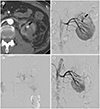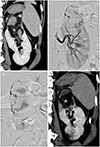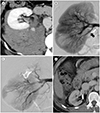Abstract
Transarterial embolization has been widely utilized in the management of urologic diseases. Acute hemorrhage can be caused by tumor, trauma, and percutaneous procedures and is the most common indication for embolization. In the past, surgical intervention was the standard treatment for urological bleeding. However, it entailed high morbidity and mortality. The demand for less-invasive treatments led to the use of transarterial embolization as an alternative to surgery. Embolization is a safe and effective treatment option for hemorrhage in various urological organs. Additionally, embolization has been employed to prevent or treat hemorrhage associated with angiomyolipoma or to treat high-flow priapism. Embolization of the target vessel in a superselective manner and use of appropriate embolic materials are key to a safe and effective procedure.
Figures and Tables
 | Fig. 1Patient who developed hematuria after partial nephrectomy for renal cell carcinoma.
A. CT reveals a pseudoaneurysm (arrow) arising from the renal artery.
B, C. Renal angiography demonstrates a pseudoaneurysm (arrow), which is superselected using a microcatheter.
D. The pseudoaneurysm was completely excluded after embolization using n-butyl cyanoacrylate glue.
|
 | Fig. 2Angiomyolipoma patient who complained of flank pain.
A. CT shows angiomyolipoma (*) in the upper pole of the left kidney.
B. Renal angiography demonstrates the tumor.
C. The lesion is superselected and embolized using polyvinyl alcohol particles (250–355 µm).
D. The tumor (*) decreases in size on the 6-month follow-up CT.
|
 | Fig. 3A 49-year-old male who developed hemorrhage after percutaneous renal biopsy.
A. CT reveals a pseudoaneurysm and hematoma in the kidney.
B. Renal angiography shows a pseudoaneurysm (arrow).
C. The affected branch is embolized using n-butyl cyanoacrylate glue and vascular plug.
D. Follow-up CT shows mild atrophy of the renal parenchyma, supplied by the embolized vessel. CT = computed tomography
|
 | Fig. 4Bladder cancer patient who complained of hematuria.
A. CT shows a tumor on the left side of the bladder.
B. The mass is opacified on left internal iliac angiography.
C. The feeding artery is superselected and embolized using Gelfoam.
|
 | Fig. 5A 34-year-old male who developed priapism.
A. Penile angiography shows contrast extravasation.
B. Embolization is performed using gelfoam.
|
References
1. MacLennan S, Imamura M, Lapitan MC, Omar MI, Lam TB, Hilvano-Cabungcal AM, et al. Systematic review of perioperative and quality-of-life outcomes following surgical management of localised renal cancer. Eur Urol. 2012; 62:1097–1117.
2. Thompson RH, Siddiqui S, Lohse CM, Leibovich BC, Russo P, Blute ML. Partial versus radical nephrectomy for 4 to 7 cm renal cortical tumors. J Urol. 2009; 182:2601–2606.
3. Pahernik S, Roos F, Hampel C, Gillitzer R, Melchior SW, Thüroff JW. Nephron sparing surgery for renal cell carcinoma with normal contralateral kidney: 25 years of experience. J Urol. 2006; 175:2027–2031.
4. Albani JM, Novick AC. Renal artery pseudoaneurysm after partial nephrectomy: three case reports and a literature review. Urology. 2003; 62:227–231.
5. Jain S, Nyirenda T, Yates J, Munver R. Incidence of renal artery pseudoaneurysm following open and minimally invasive partial nephrectomy: a systematic review and comparative analysis. J Urol. 2013; 189:1643–1648.
6. Hyams ES, Pierorazio P, Proteek O, Sukumar S, Wagner AA, Mechaber JL, et al. Iatrogenic vascular lesions after minimally invasive partial nephrectomy: a multi-institutional study of clinical and renal functional outcomes. Urology. 2011; 78:820–826.
7. Shin J, Han K, Kwon JH, Kim GM, Kim D, Han SC, et al. Clinical results of transarterial embolization to control postoperative vascular complications after partial nephrectomy. J Urol. 2019; 201:702–708.
8. Leslie S, Goh AC, Gill IS. Partial nephrectomy--contemporary indications, techniques and outcomes. Nat Rev Urol. 2013; 10:275–283.
9. Shapiro EY, Hakimi AA, Hyams ES, Cynamon J, Stifelman M, Ghavamian R. Renal artery pseudoaneurysm following laparoscopic partial nephrectomy. Urology. 2009; 74:819–823.
10. Jeon CH, Seong NJ, Yoon CJ, Byun SS, Lee SE. Clinical results of renal artery embolization to control postoperative hemorrhage after partial nephrectomy. Acta Radiol Open. 2016; 5:2058460116655833.
11. Chen J, Yang M, Wu P, Li T, Ning X, Peng S, et al. Renal arterial pseudoaneurysm and renal arteriovenous fistula following partial nephrectomy. Urol Int. 2018; 100:368–374.
12. Gahan JC, Gaitonde M, Wadskier L, Cadeddu JA, Trimmer C. Renal function outcomes following selective angioembolization for iatrogenic vascular lesions after partial nephrectomy. J Endourol. 2013; 27:1516–1519.
13. Strobl FF, D'Anastasi M, Hinzpeter R, Franke PS, Trumm CG, Waggershauser T, et al. Renal pseudoaneurysms and arteriovenous fistulas as a complication of nephron-sparing partial nephrectomy: technical and functional outcomes of patients treated with selective microcoil embolization during a ten-year period. Rofo. 2016; 188:188–194.
14. Ghoneim TP, Thornton RH, Solomon SB, Adamy A, Favaretto RL, Russo P. Selective arterial embolization for pseudoaneurysms and arteriovenous fistula of renal artery branches following partial nephrectomy. J Urol. 2011; 185:2061–2065.
15. Han K, Ahmed BM, Kim MD, Won JY, Lee DY, Kim GM, et al. Clinical outcome of transarterial embolization for postgastrectomy arterial bleeding. Gastric Cancer. 2017; 20:887–894.
16. Huang YS, Chang CC, Liou JM, Jaw FS, Liu KL. Transcatheter arterial embolization with N-butyl cyanoacrylate for nonvariceal upper gastrointestinal bleeding in hemodynamically unstable patients: results and predictors of clinical outcomes. J Vasc Interv Radiol. 2014; 25:1850–1857.
17. Koo HJ, Shin JH, Kim HJ, Kim J, Yoon HK, Ko GY, et al. Clinical outcome of transcatheter arterial embolization with N-butyl-2-cyanoacrylate for control of acute gastrointestinal tract bleeding. AJR Am J Roentgenol. 2015; 204:662–668.
18. Koo KC, Kim WT, Ham WS, Lee JS, Ju HJ, Choi YD. Trends of presentation and clinical outcome of treated renal angiomyolipoma. Yonsei Med J. 2010; 51:728–734.
19. Soulen MC, Faykus MH Jr, Shlansky-Goldberg RD, Wein AJ, Cope C. Elective embolization for prevention of hemorrhage from renal angiomyolipomas. J Vasc Interv Radiol. 1994; 5:587–591.
20. Murray TE, Lee MJ. Are we overtreating renal angiomyolipoma: a review of the literature and assessment of contemporary management and follow-up strategies. Cardiovasc Intervent Radiol. 2018; 41:525–536.
21. Mues AC, Palacios JM, Haramis G, Casazza C, Badani K, Gupta M, et al. Contemporary experience in the management of angiomyolipoma. J Endourol. 2010; 24:1883–1886.
22. Oesterling JE, Fishman EK, Goldman SM, Marshall FF. The management of renal angiomyolipoma. J Urol. 1986; 135:1121–1124.
23. Lenton J, Kessel D, Watkinson AF. Embolization of renal angiomyolipoma: immediate complications and long-term outcomes. Clin Radiol. 2008; 63:864–870.
24. Nelson CP, Sanda MG. Contemporary diagnosis and management of renal angiomyolipoma. J Urol. 2002; 168:1315–1325.
25. Lienert AR, Nicol D. Renal angiomyolipoma. BJU Int. 2012; 110:Suppl 4. 25–27.
26. Faddegon S, So A. Treatment of angiomyolipoma at a tertiary care centre: the decision between surgery and angioembolization. Can Urol Assoc J. 2011; 5:E138–E141.
27. Murray TE, Doyle F, Lee M. Transarterial embolization of angiomyolipoma: a systematic review. J Urol. 2015; 194:635–639.
28. Mourikis D, Chatziioannou A, Antoniou A, Kehagias D, Gikas D, Vlahos L. Selective arterial embolization in the management of symptomatic renal angiomyolipomas. Eur J Radiol. 1999; 32:153–159.
29. Dickinson M, Ruckle H, Beaghler M, Hadley HR. Renal angiomyolipoma: optimal treatment based on size and symptoms. Clin Nephrol. 1998; 49:281–286.
30. Hocquelet A, Cornelis F, Le Bras Y, Meyer M, Tricaud E, Lasserre AS, et al. Long-term results of preventive embolization of renal angiomyolipomas: evaluation of predictive factors of volume decrease. Eur Radiol. 2014; 24:1785–1793.
31. Ramon J, Rimon U, Garniek A, Golan G, Bensaid P, Kitrey ND, et al. Renal angiomyolipoma: long-term results following selective arterial embolization. Eur Urol. 2009; 55:1155–1161.
32. Summerton DJ, Kitrey ND, Lumen N, Serafetinidis E, Djakovic N. European Association of Urology. EAU guidelines on iatrogenic trauma. Eur Urol. 2012; 62:628–639.
33. Dinkel HP, Danuser H, Triller J. Blunt renal trauma: minimally invasive management with microcatheter embolization experience in nine patients. Radiology. 2002; 223:723–730.
34. Dorffner R, Thurnher S, Prokesch R, Bankier A, Turetschek K, Schmidt A, et al. Embolization of iatrogenic vascular injuries of renal transplants: immediate and follow-up results. Cardiovasc Intervent Radiol. 1998; 21:129–134.
35. Perini S, Gordon RL, LaBerge JM, Kerlan RK Jr, Wilson MW, Feng S, et al. Transcatheter embolization of biopsy-related vascular injury in the transplant kidney: immediate and long-term outcome. J Vasc Interv Radiol. 1998; 9:1011–1019.
36. Poulakis V, Ferakis N, Becht E, Deliveliotis C, Duex M. Treatment of renal-vascular injury by transcatheter embolization: immediate and long-term effects on renal function. J Endourol. 2006; 20:405–409.
37. Sam K, Gahide G, Soulez G, Giroux MF, Oliva VL, Perreault P, et al. Percutaneous embolization of iatrogenic arterial kidney injuries: safety, efficacy, and impact on blood pressure and renal function. J Vasc Interv Radiol. 2011; 22:1563–1568.
38. Choi MJ, Kim PH, Shin JH, Kim JW, Gwon DI, Kim JH, et al. Angiographic management of percutaneous renal procedure-related bleeding: a single-center experience. Int J Urol. 2019; 26:406–412.
39. Mavili E, Dönmez H, Ozcan N, Sipahiogğlu M, Demirta¸s A. Transarterial embolization for renal arterial bleeding. Diagn Interv Radiol. 2009; 15:143–147.
40. Park HJ, Shin JH, Han KC, Yoon HK, Ko GY, Sung KB. Transcatheter arterial embolization of angiographically visible and occult renal capsular artery hemorrhage in 28 patients. J Vasc Interv Radiol. 2016; 27:973–980.
41. Choong SK, Walkden M, Kirby R. The management of intractable haematuria. BJU Int. 2000; 86:951–959.
42. Delgal A, Cercueil JP, Koutlidis N, Michel F, Kermarrec I, Mourey E, et al. Outcome of transcatheter arterial embolization for bladder and prostate hemorrhage. J Urol. 2010; 183:1947–1953.
43. Prasad V, Sacks BA, Kraus S, Clouse ME. Embolotherapy for lower urinary tract hemorrhage. J Vasc Interv Radiol. 2009; 20:965–970.
44. Rastinehad AR, Caplin DM, Ost MC, VanderBrink BA, Lobko I, Badlani GH, et al. Selective arterial prostatic embolization (SAPE) for refractory hematuria of prostatic origin. Urology. 2008; 71:181–184.
45. Pisco JM, Martins JM, Correia MG. Internal iliac artery: embolization to control hemorrhage from pelvic neoplasms. Radiology. 1989; 172:337–339.
46. Pautler SE, Brock GB. Priapism. From priapus to the present time. Urol Clin North Am. 2001; 28:391–340.
47. Sánchez-López S, González-Gómez S, Di Lizio-Miele K, González-Gómez J. High-flow priapism treated with superselective transcatheter embolization using polyvinyl alcohol particles. SAGE Open Med Case Rep. 2017; 5:2050313X17693179.
48. Burnett AL, Bivalacqua TJ. Priapism: new concepts in medical and surgical management. Urol Clin North Am. 2011; 38:185–194.
49. Liu BX, Xin ZC, Zou YH, Tian L, Wu YG, Wu XJ, et al. High-flow priapism: superselective cavernous artery embolization with microcoils. Urology. 2008; 72:571–573.
50. Wear JB Jr, Crummy AB, Munson BO. A new approach to the treatment of priapism. J Urol. 1977; 117:252–254.
51. Montague DK, Jarow J, Broderick GA, Dmochowski RR, Heaton JP, Lue TF, et al. American Urological Association guideline on the management of priapism. J Urol. 2003; 170:1318–1324.
52. Bastuba MD, Saenz de, Dinlenc CZ, Sarazen A, Krane RJ, Goldstein I. Arterial priapism: diagnosis, treatment and long-term followup. J Urol. 1994; 151:1231–1237.
53. Park JK, Jeong YB, Han YM. Recanalization of embolized cavernosal artery: restoring potency in the patient with high flow priapism. J Urol. 2001; 165:2002–2003.
54. Kim KR, Shin JH, Song HY, Ko GY, Yoon HK, Sung KB, et al. Treatment of high-flow priapism with superselective transcatheter embolization in 27 patients: a multicenter study. J Vasc Interv Radiol. 2007; 18:1222–1226.
55. Kojima H, Tanigawa N, Kariya S, Komemushi A, Shomura Y, Yanishi M, et al. High-flow priapism undergoing arterial embolization: review of literature following American Urological Association guideline on the management of priapism. Minim Invasive Ther Allied Technol. 2009; 18:1–5.
56. Heye S, Maleux G, Van Poppel H, Oyen R, Wilms G. Hemorrhagic complications after nephron-sparing surgery: angiographic diagnosis and management by transcatheter embolization. AJR Am J Roentgenol. 2005; 184:1661–1664.
57. Netsch C, Brüning R, Bach T, Gross AJ. Management of renal artery pseudoaneurysm after partial nephrectomy. World J Urol. 2010; 28:519–524.




 PDF
PDF ePub
ePub Citation
Citation Print
Print





 XML Download
XML Download